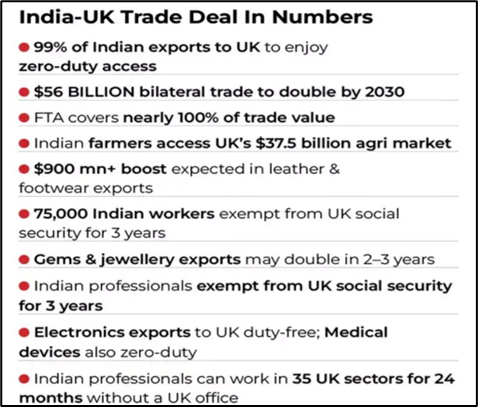Why in news?
India and the United Kingdom signed a landmark Comprehensive Economic Trade Agreement (CETA) during Prime Minister Narendra Modi’s visit to the U.K.
Alongside the agreement, both countries unveiled a new strategic cooperation plan — the India-U.K. Vision 2035, replacing the earlier Roadmap 2030. The Vision document outlines a comprehensive roadmap to deepen strategic ties across trade, technology, defence, education, climate, and innovation. It aims to boost jobs, investments, clean energy, and people-to-people links, anchored in shared democratic values and high-level political engagement to ensure mutual growth and global leadership.
What’s in Today’s Article?
- Key Highlights of the India-UK Free Trade Agreement
- Impact of India-UK Trade Deal
- Conclusion
Key Highlights of the India-UK Free Trade Agreement
- The India-UK Free Trade Agreement (FTA), signed on July 24, 2025, offers comprehensive economic gains for India across goods, services, and labour mobility.
- Here’s a sector-wise summary:

- Market Access: 99% Duty-Free Trade
- India’s Gains: 99% of Indian exports to the UK will now be duty-free, benefitting nearly all trade value.
- UK’s Gains: 90% of tariff lines will be reduced, with 85% becoming zero-duty within 10 years.
- Sectors Impacted: Labour-intensive industries like marine, textiles, chemicals, base metals, and processed foods.
- Tariffs on processed foods drop from 70% to zero; tea, coffee, spices, rubber, and plastics gain free access.
- Agriculture: Boost to Rural Economy
- Duty-Free Access: 95%+ tariff lines now zero-duty.
- Products Covered: Fruits, vegetables, pulses, spices, pickles, jackfruit, millets, organic herbs.
- Export Potential: Agri-exports could rise 20% in 3 years, aiding India’s $100B agri-export target by 2030.
- Sensitive Items Protected: Dairy, oats, apples, edible oils.
- Marine Products: A $5.4 Billion Opportunity
- Tariff Elimination: Zero tariffs on shrimp, tuna, fishmeal, etc.
- Current Share: India has only 2.25% share in UK marine imports.
- Growth Potential: Major boost expected for India’s coastal economy.
- Textiles & Apparel: Enhanced Competitiveness
- Coverage: 1,143 product categories, all duty-free.
- Market Impact: India may gain 5% more UK market share.
- Key Products: Ready-made garments, carpets, handicrafts, home textiles.
- Advantage: Levels playing field with Bangladesh and Cambodia.
- Engineering Goods: Export Surge Expected
- Current Status: $4.28B exports to UK; UK imports $193.5B globally.
- Tariff Cuts: Up to 18% duties scrapped.
- Projection: Engineering exports may double to $7.5B by 2030.
- Pharmaceuticals & Medical Devices
- Tariff Elimination: On generic medicines and medical devices.
- Market Potential: UK imports $30B pharma; India exports just $1B.
- Products Covered: ECG machines, X-ray systems, surgical equipment.
- Chemicals & Plastics
- Chemical Sector: Exports to rise 30–40% to $650–750M in FY26.
- Plastic Sector: Focus on films, sheets, kitchenware; 15% export growth targeted.
- Advantage: More competitive pricing versus global suppliers.
- Toys, Sports Goods, Gems & Jewellery
- Toys & Sports Goods: Export edge over China and Vietnam.
- Jewellery: Exports may double in 2–3 years to capture UK’s $3B market.
- Leather & Footwear
- Tariff Removal: 16% duties scrapped.
- Export Target: To exceed $900M.
- Beneficiaries: MSME hubs in Agra, Kanpur, Kolhapur, Chennai.
- Services & Professionals: A Global Edge
- Worker Benefits: 75,000 Indians exempt from UK social security for 3 years.
- Sectors Opened: 36 services sectors without Economic Needs Test.
- Professional Access: Indian professionals can work in 35 UK sectors for 2 years.
- Cultural Exchange: 1,800 chefs, yoga trainers, and artists to be welcomed annually.
Impact of India-UK Trade Deal
- Gains for Indian Sectors - India’s key export sectors — including agriculture, processed food, textiles, footwear, seafood, gems and jewellery, and engineering goods — will enjoy expanded market access in the U.K. thanks to reduced tariffs.
- Benefits for British Exports - British exporters will also benefit significantly. The deal is set to ease the sale of whisky, cars, and other British goods in India, helping diversify and broaden the trade portfolio.
- Boost to Bilateral Trade - UK exports to India are projected to grow by nearly 60%, contributing an additional £15.7 billion by 2040. Overall bilateral trade is expected to surge by 39%, adding £25.5 billion annually compared to trade levels in the absence of the agreement.
- Services and Mobility Provisions - The FTA includes chapters on services, innovation, and intellectual property, offering enhanced mobility for Indian professionals.
- Additionally, a Double Contribution Convention Agreement will prevent Indian workers in the UK from paying into both Indian and British social security systems.
- Strategic Shift after RCEP Exit - India's decision to exit the RCEP in 2019 due to fears of Chinese import surges shifted focus to Western economies. The India-UK deal is part of India’s strategy to forge stronger ties with high-income nations like the UK and EU.
Conclusion
The India–UK FTA marks a pivotal shift in India’s global trade posture. It not only strengthens bilateral relations but also signals India's readiness to engage in complex, high-standard economic agreements aligned with its broader goals of export growth, services integration, and global competitiveness.










